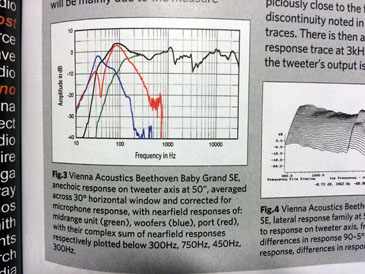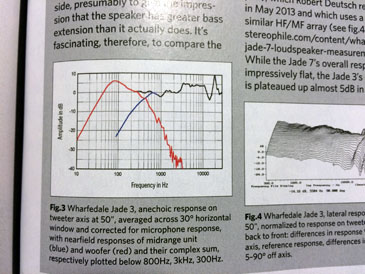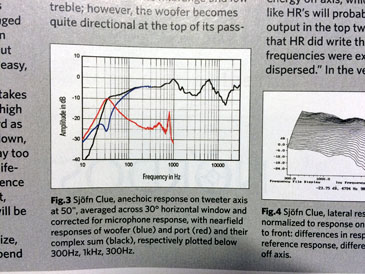How flat is flat?
Copyright 2014 © Troels Gravesen
Magazine Stereophile may come after me for publishing from their articles, but I hope they’ll forgive me for posting some graphs and commenting on three recent loudspeaker reviews and the measurements associated. I highly recommend this magazine, not least due to the measurements carried out by John Atkinson. If you're into speaker design, you will find Mr. Atkinson’s measurements of value in evaluating your own designs. Few of us have the opportunity to perform measurements and compare sonic quality from such large number of speakers.
For those not familiar with measurements we can do anechoic measurements down to around 250-300 Hz in a normal living room before the measurement starts including room reflections. Placing the microphone 1 mm from the cone of the bass driver, we get a response pretty much telling what the driver would do if mounted on an infinite baffle in an anechoic room. Most measuring software allow us to merge different measurements, thus we can merge near-field response with far-field response and get a decent picture of what the driver does between 20 Hz to 20 kHz.
The interpretation of Mr. Atkinson’s measurements must take into account the merging of far-field response (mid-treble) and bass near-field response, as the near-field response includes the roll-off characteristic from running the bass driver from its crossover, thus we often have a huge bump around 80-120 Hz, not really what the speaker delivers in a room despite the inevitable room-gain.
My point in showing the graphs below is that if I ever launched a speaker performing this badly, no one would probably build it. What manufacturers sometimes can get away with and still get favourable reviews is an interesting journey into the reviewer's ability to write something nice about a product that may be basically flawed, but also that some speakers may deliver poor measuring performance and yet sounding pleasing to the ear. As pointed out by Vandersteen, linear distortion may be severe without distress to the ear as long as phase shifts are modest, so we shouldn't necessarily discard a speaker showing some linear distortion. Non-linear distortion is another matter!
We all know that magazines are dependent on advertising and that's all fine as long as we keep in mind that it is so. Often reviewers hear products at hifi shows and ask for samples for review, thus already have positive expectations to the product, otherwise he probably wouldn't have asked for it.



Click images to view large.
From left to right:
Vienna Acoustics Beethoven Baby Grand Symphony Edition,
Wharfedale Jade
3 and Sjöfn Clue.
I rush to say I've only heard the Vienna Acoustics of these three speakers, and I wasn't impressed by the Vienna from a harsh upper mid and treble performance, something that seems plausible from the ragged upper-mid/treble performance. Plus/minus 5 dB from 1-10 kHz must be derived from some serious phase issue, right where the ear is most sensitive. Even a Lowther can sometimes do better than this.
The Wharfedale measurements look really strange and I have my doubts about the speaker or the actual measurements because from the Jade 7, featuring basically the same three upper drivers, we see a really nice frequency response. Having a +5 dB from 3-11 kHz would from any speaker I've made hurt your ears in a few minutes. I have a hard time believing these measurements are actually correct - or the speaker is faulty. It appears the upper middome has been merged with nearfield response (blue line) and the summed response (small black line between bass and mid/tweeter is really not the correct summation, or? Why would Peter Comeau produce such a strange tonal balance?
The Sjöfn review is interesting because the reviewer was so taken by the product at the show - and not so taken when it entered his living room, and for once it has some critical comments and the manufacturer got pissed and starts quoting numerous positive statements from people hearing the speaker at various shows. Now, that's what makes magazines entertaining – when we really can’t find something better to do. Because describing sound is like describing food or wine, we really don’t know what it tastes like until we’ve tasted it ourselves.
I suggest visiting Stereophile's website to read the reviews and see how it takes some reading between the lines to extract the essentials.
http://www.stereophile.com/content/sjöfn-hifi-clue-loudspeaker
http://www.stereophile.com/content/wharfedale-jade-3-loudspeaker